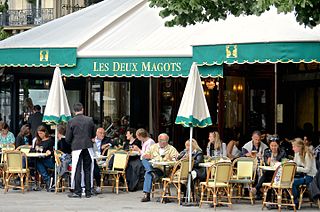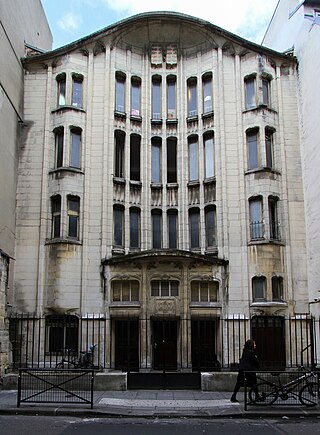
The 6th arrondissement of Paris is one of the 20 arrondissements of the capital city of France. In spoken French, it is referred to as le sixième.

The Collège Stanislas de Paris, colloquially known as Stan, is a private Catholic school in Paris, situated on "Rue Notre-Dame-des-Champs" in the 6th arrondissement. It has more than 3,000 students, from preschool to classes préparatoires, and is the largest private school in France. Stanislas is considered one of the most prestigious and elite French schools. The school was ranked 1st from 2019 to 2022 for middle school and 1st in 2019 for high school.

The Agoudas Hakehilos Synagogue is an Orthodox Jewish congregation and synagogue, located at 10 rue Pavée, in Le Marais quarter, in the IVe arrondissement of Paris, France. The synagogue is commonly referred to as the Pavée synagogue, rue Pavée synagogue, or Guimard synagogue, and was completed in 1914, designed by Hector Guimard in the Art Nouveau style. The congregation worships in the Ashzenazi rite, led by Rav Moredekhai Rottenberg, the son of the late Rav Haim Yaakov Rottenberg, known as the Rouv. The synagogue is open to the public.
David Feuerwerker was a French Jewish rabbi and professor of Jewish history who was effective in the resistance to German occupation the Second World War. He was completely unsuspected until six months before the war ended, when he fled to Switzerland and his wife and baby went underground in France. The French government cited him for his bravery with several awards. After the war, he and his wife re-established the Jewish community of Lyon. He settled in Paris, teaching at the Sorbonne. In 1966, he and his family, grown to six children, moved to Montreal, where he developed a department of Jewish studies at the University of Montreal.

The Union Libérale Israélite de France, commonly referred to as the rue Copernic synagogue, is a Reform Jewish congregation and synagogue, located in the XVIe arrondissement of Paris, France. Inaugurated on 1 December 1907, it is the oldest Reform synagogue in France.

Located at 6, rue Notre-Dame-des-Victoires, in the 2nd arrondissement of Paris, The Basilica of Notre-Dame-des-Victoires is one of ten minor basilicas located in the Île-de-France region of France. It was begun as an Abbey church, and constructed between 1629 and 1740 in the French classical style. Its name was given by King Louis XIII, who dedicated it to his victory over the Protestants at La Rochelle in 1628 during the French Wars of Religion. Notre-Dame-des-Victoires is famous for the ex voto offerings left there by the faithful. Over 37,000 devotional plaques, silver and gold hearts, as well as military decorations, have been left at the basilica. The closest Métro station is 'Bourse'.

Jean Beausire was an architect, engineer and fountain-maker and the chief of public works in Paris for King Louis XIV of France and King Louis XV of France between 1684 and 1740, and was the architect of all the public fountains constructed in Paris that period. Several of his fountains still exist and continue to work. Three streets in the 4th arrondissement of Paris today carry his name: Rue Jean-Beausire, Impasse Jean-Beausire, and Passage Jean-Beausire.
The modern Reform Cantorate is seen as a result of developments that took place during the 19th century, largely in Europe. The process continued to evolve in America following the emigration of German Reform Jews towards the end of the century.

The Great Synagogue in Lyon is an Orthodox Jewish congregation and synagogue located at 13 quai Tilsitt in the IIe arrondissement of Lyon, France. Designed by Abraham Hirsch in the Byzantine Revival style, the synagogue was built between 1863 and 1864 and renovated in 2014. The building was listed as a monument historique on 5 December 1984. The congregation worships in the Ashkenazi rite.

The Grand Synagogue of Paris, generally known as Synagogue de la Victoire or Grande Synagogue de la Victoire, is an Orthodox Jewish congregation and synagogue, located at 44, Rue de la Victoire, in the IXe arrondissement of Paris, France.

Music in the city of Paris, France, includes a variety of genres, from opera and symphonic music to musical theater, jazz, rock, rap, hip-hop, the traditional Bal-musette and gypsy jazz, and every variety of world music, particularly music from Africa and North Africa. such as the Algerian-born music known as Raï. Leading musical institutions include the Paris Opera, the Orchestre de Paris, and the Paris Conservatory, the first state music conservatory in Europe. The Cité de la Musique at La Villette is home of the new Paris Symphony Hall, the Conservatory, a museum of musical instruments, and Le Zenith, a major venue for popular music. Many of the churches in Paris have magnificent historic organs, and often host concerts. The city is also known for its music halls and clubs.

Notre-Dame-de-la-Salette is a Roman Catholic church located rue de Cronstadt in the 15th arrondissement of Paris. It is under the patronage of Our Lady of La Salette, particularly revered by the religious congregation of St. Vincent de Paul.

The Synagogue Don Isaac Abravanel, also known as the Synagogue de la Roquette, is an Orthodox Jewish congregation and synagogue, located in the XIe arrondissement of Paris, France. Designed by architects Alexandre Persitz and Arthur-Georges Héaume in the Modernist style, the synagogue was built in 1962 for Jews who emigrated to France from Algeria, Morocco and Tunisia as a result of decolonization. The congregation worships in the Sephardi rite.

The Synagogue of Lausanne is a Jewish congregation and synagogue, located at 1 Avenue de Florimont in Lausanne, Vaud, Switzerland. The building is a Cultural Property of National Significance.

The Luxembourg Synagogue is an Orthodox Jewish synagogue, located on Avenue Monterey, in Luxembourg City, Luxembourg.

On the night of October 2–3, 1941, six synagogues were attacked in Paris and damaged by explosive devices places by their doors between 2:05 and 4:05 am. The perpetrators were identified but not arrested.

The Great Synagogue of Marseille is a Jewish congregation and synagogue, located on Rue Breteuil in the 6th arrondissement of Marseille, France. The building was listed as a monument historique in 2007. The congregation worships in the Sephardi rite.

The Rouen Synagogue is an Orthodox Jewish congregation and synagogue, located at 55 rue des Bons-Enfants in Rouen, in the region of Normandy, France. The congregation is affiliated with the Israelite Central Consitory of France, and worships in the Sephardic rite.

The Synagogue of Chasseloup-Laubat is a Jewish synagogue located at 14 Rue Chasseloup-Laubat in Paris' 15th arrondissement. The synagogue is associated with the Israelite Central Consistory of France.






















